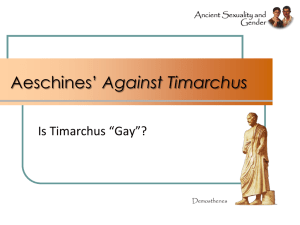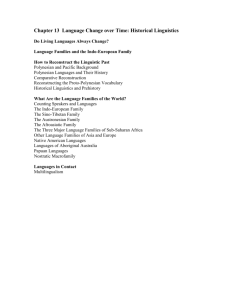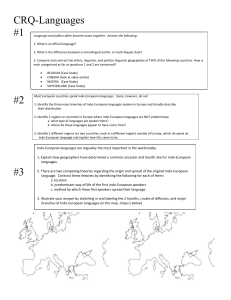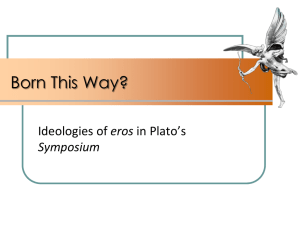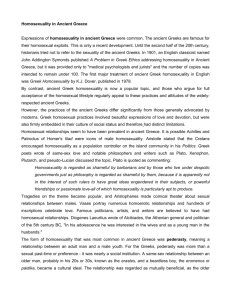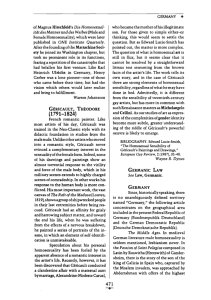Walter L. Williams Sergent's Thesis. Recently Ber
advertisement
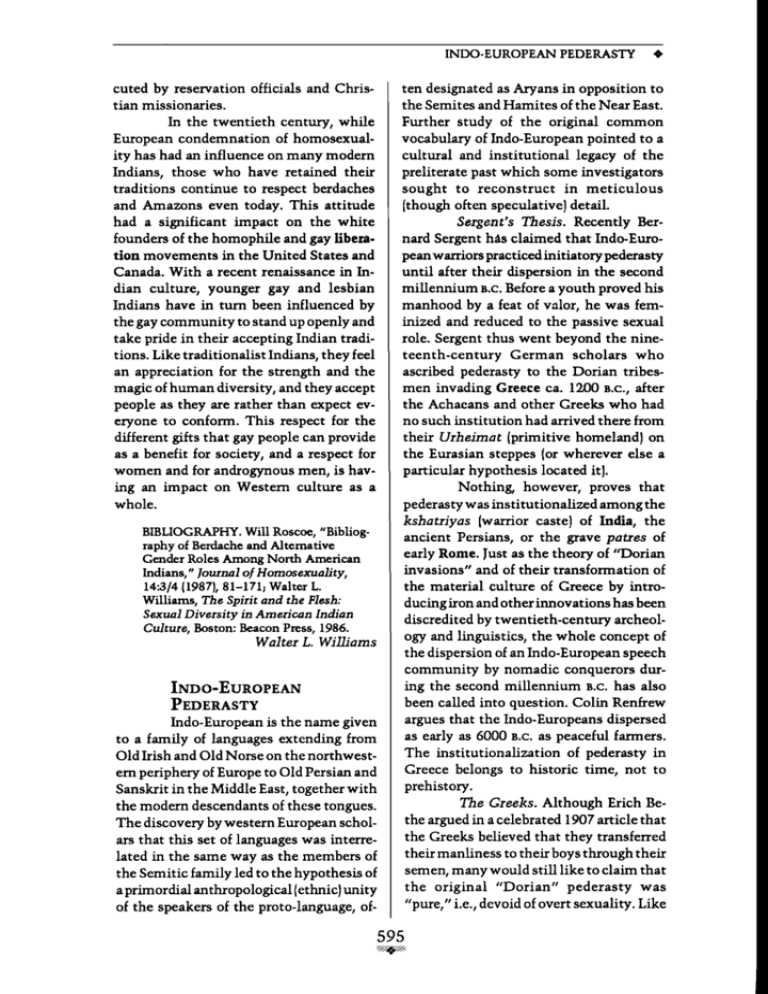
INDO-EUROPEAN PEDERASTY cuted by reservation officials and Christian missionaries. In the twentieth century, while European condemnation of homosexuality has had an influence on many modern Indians, those who have retained their traditions continue to respect berdaches and Amazons even today. This attitude had a significant impact on the white founders of the homophile and gay libera· tion movements in the United States and Canada. With a recent renaissance in Indian culture, younger gay and lesbian Indians have in turn been influenced by the gay community to stand up openly and take pride in their accepting Indian traditions. Like traditionalist Indians, they feel an appreciation for the strength and the magic of human diversity, and they accept people as they are rather than expect everyone to conform. This respect for the different gifts that gay people can provide as a benefit for society, and a respect for women and for androgynous men, is having an impact on Western culture as a whole. BIBLIOGRAPHY. Will Roscoe, "Bibliography of Berdache and Alternative Gender Roles Among North American Indians," lOUJ:lltll of Homosexuality, 14:3/4 (1987),81-171; Walter L. Williams, The Spirit and the Flesh: Sexual Diversity in American Indian Culture, Boston: Beacon Press, 1986. Walter L. Williams INDO-EuROPEAN PEDERASTY Indo-European is the name given to a family of languages extending from Old Irish and Old Norse on the northwestern periphery of Europe to Old Persian and Sanskrit in the Middle East, together with the modern descendants of these tongues. The discovery by western European scholars that this set of languages was interrelated in the same way as the members of the Semitic family led to the hypothesis of a primordial anthropological (ethnic) unity of the speakers of the proto-language, of- + ten designated as Aryans in opposition to the Semites and Hamites of the Near East. Further study of the original common vocabulary of Indo-European pointed to a cultural and institutional legacy of the preliterate past which some investigators sought to reconstruct in meticulous (though often speculative) detail. Sergent's Thesis. Recently Bernard Sergent Ms claimed that Indo-Europeanwarriors practiced initiatory pederasty until after their dispersion in the second millennium B.C. Before a youth proved his manhood by a feat of valor, he was feminized and reduced to the passive sexual role. Sergent thus went beyond the nineteenth-century German scholars who ascribed pederasty to the Dorian tribesmen invading Greece ca. 1200 B.C., after the Achaeans and other Greeks who had no such institution had arrived there from their Urheimat (primitive homeland) on the Eurasian steppes (or wherever else a particular hypothesis located itl. Nothin& however, proves that pederasty was institutionalized among the kshatriyas (warrior caste) of India, the ancient Persians, or the grave patres of early Rome. Just as the theory of "Dorian invasions" and of their transformation of the material culture of Greece by introducing iron and other innovations has been discredited by twentieth-century archeology and linguistics, the whole concept of the dispersion of an Indo-European speech community by nomadic conquerors during the second millennium B.C. has also been called into question. Colin Renfrew argues that the Indo-Europeans dispersed as early as 6000 B.C. as peaceful farmers. The institutionalization of pederasty in Greece belongs to historic time, not to prehistory. The Greeks. Although Erich Bethe argued in a celebrated 1907 article that the Greeks believed that they transferred their manliness to their boys through their semen, many would still like to claim that the original "Dorian" pederasty was "pure," i.e., devoid of overt sexuality. Like 595 ::;:;:.:::;::: • INDO·EUROPEAN PEDERASTY most of the ancients, Cicero viewed Spartan mores with a grain of salt, even though they claimed not to soil even the thighs of their boys: "The Lacedemonians, while they permit all things except outrage in the love of youths, certainly distinguish the forbidden by a thin wall of partition from the sanctioned, for they allow embraces and a common couch to lovers" IDe Republica, IV 4). Vase painting, graffiti, and literary allusions leave no doubt that intercrural and even anal intercourse were frequent and expected. Black-figured vases portray sexual contact more explicitly, with youths having larger virile members and more mature bodies, than the redfigured ones that replaced them after ca. 520 B.C. Even if Zaleucus, the earliest coloniallawgiverwho copied much from Crete, may have introduced pederasty to Locri in 664 B.C., the pederasty of Phalanthus, Spartan colonizer of Tarentum in 706 B.C., was just another founder's myth. The attempts of Sergent's mentor Ceorges Dumezil to name the god or hero who established pederasty in every polis shows that its origin had to be justified in each, as Bethe realized long ago when he claimed that the practice spread to the other citystates from Sparta. The institutionalization of pederasty followed rather than preceded the rise of the city·states during the eighth century B.C. One should not conclude with Sergent that Greek paiderasteia was "not started by the influence of the Dorians or of any others." It began in Crete in the seventh century B.C. and was popularized by Sparta's military and ath· letic prowess before spreading to most of the rest of Hellas during the sixth century B.C. Other Peoples. Inadequate also is the documentation that any other IndoEuropean peoples ever practiced initiatory pederasty. It has been claimed that Tacitus depicted the Germans as drowning "passive homosexuals" in bogs; recent scholarship has demonstrated that Tacitus' expression meant "cowards and shirkers in combat." Two other historians, however, Ammianus Marcellinus, writing ca. A.D. 380 and, more ambiguously, Procopius, writing ca. 550, expressed disgust that Germanic tribes, Taifales and Heruls, practiced pederasty. In the early Middle Ages Germanic law also failed to mention homosexual acts, except under Christian influence in Visigothic Spain. While Sergent omitted evidence from the Irish pen. itentials for Celtic pederasty, he implausibly rationalized Caesar's silence in the Gallic Wars by claiming that the Roman general feared criticism of his own proclivities. A recent effort at demolishing the Indo-European theory is Martin Bernal's thesis in Black Athena (New Brunswick, 1987) that the Greeks did not bring with them from the Eurasian heartland the genius, the ideas, and the institutions from which Western civilization evolved, but borrowed them from the Hamitic and Semitic peoples of the eastern Mediterranean. It was only the racism and antiSemitism of nineteenth-century Germany that invented the"Aryan model" of Hellenic greatness. It is true that Greek civilization began in the south'and east-the interface with the far older cultures of Egypt, Syria, and Mesopotamia-and that in the sphere ofmaterial culture the Greeks and Romans and even their successor nations did not innovate; they merely adopted the heritage of the Near Eastern peoples. But in politics, in science, and in philosophy the Hellenes were supremely original: the Near East simply had no counterpart to their democratic city-states or to their achievements in speculative thought. Moreover, it may be argued that the pederastic spirit guarded the cradle of Western civilization, shieldingit well from the despotism and servility of the Persians and their client-peoples-with religions that rejected and condemned homosexual expression as an abomination in the sight of their deities. Though suggestive, the notion of a common Indo-European tradi- 596 ;;"<f"':; INOONESIA tion of initiatory pederasty long antedating the rise of Hellenic civilization remains essentially hypothetical. BIBLIOGRAPHY. Erich Bethe, "Die dorische Knabenliebe: ihre Ethik und ihre Idee," Rheinisches Museum, 62 (1907),438-75; Karl Otfried MUller, Die Dorier [1820-24), vols. 2 and 3 trans. as The History and Antiquities of the Doric Race, London: John Murray, 1830; Colin Renfrew, Archaeology and Language: The Puzzle of Indo-European Origins, Cambridge: Cambridge University Press, 1988; Bernard Sergent, L'hamoseXlUllite initiatique dans l'Eurape ancienne, Paris: Payot, 1986; Homosexuality in Greek Myth, trans. by Arthur Goldhammer, Boston: Beacon Press, 1986. Wimam A. Percy INDONESIA This island nation shares with its Southeast Asian neighbors a heritage of acceptance of homosexual behavior in its traditional cultures. Though littleis known about the same-sex practices of many of the tribes of the East Indies, there is information from early explorers about several cultures. Among both the Dayak (Iban) of Kalimantan, and the Bugis (Makasar) of Sulawesi, there was a socially-recognized "half-man/half-woman" androgynous role for males similar to the berdache tradition among American Indians. Such individuals were often sacred religious leaders of great spiritual power, wore a mixture of men's and women's clothes, combined masculine and feminine aspects in their character, and had sex with men. Among the Bugis, such bisu individuals traditionally resided at the courts of local rulers, where they took care of the sacred royal ornaments. Melanesian Cultures. In contrast, the eastern part of Indonesia is Irian Jaya, which is a totally different culture area from the rest of the nation. Irian is the western part of the island of Papua New Guinea, where the tribes share the Pacific Melanesian way of life. Melanesian cuI· tures emphasize super-masculinity for ... males, who are grouped together in warriorhoods. In these societies, feminized males are looked down upon, and boys are pressured to adopt the masculine warrior lifestyle. One means of gaining masculinity, in the lifestyle of many of these Melanesian cultures, is for a boy to absorb masculine characteristics through sex with a man. Accordingly, every boy is expected to go through a stage of growth, in which he either orally ingests or anally receives semen. It is believed that he cannot mature into manhood without gaining this sperm through homosexual acts, even though he will marry heterosexually after he matures. Homosexual relations, often done in a ritual context, provide a major means for transmission of masculine values from one generation of males to an· other. Javanese Culture. The major culture of Indonesia is Javanese, and only in the Ponorogo area of eastern Java is homosexuality institutionalized in man-boy relationships. Here, however, boys are valued for their feminine characteristics, and men will take a boy as a gemblakan. Traditionally, gemblakans were kept by a warak, a spiritually and physically powerful masculine adult man. Waroks would gain social status by the lavish wealth they could display on their beautiful gemblakan. A man would ar· range with the boy's parents to keep him for one or two years, and would present the parents with gifts and financial support during the time in which he kept the boy. Some gemblakans were as young as seven years old, but most were in their teens, and some were loved so much by their man that they stayed together until the boy was in his twenties. In recent decades, however, it has become too expensive for most men to support a gemblakan, so in the traditional villages of Ponorogo where the practice still continues, several men will combine their resources to share a boy. The group of men is usually either young and unmar· ried or a royal dance troupe, where the boy 597 ;f::~.:::::::
